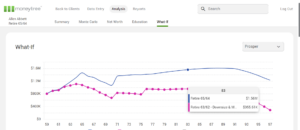Your clients have complex financial lives, and that includes their taxable, tax-free, and tax deferred income strategies. Distribution strategies are highly personal. For example, your clients may hold a charity near and dear to their heart. Maybe their medical expenses are accumulating, or maybe they just don’t know the best way to handle their tax situation. Whatever the challenge, your clients depend on you for advice. Moneytree is built to empower you, the advisor, to not only customize, but personalize their distribution strategy by allowing you to select the order in which assets are distributed, both before and during retirement.
Automated Withdrawals
The order can be changed for pre-retirement and retirement periods.
By default, the application follows this withdrawal order:
- Taxable (such as checking and savings)
- Equity/Other (such as stock and mutual funds)
- Tax Free (such as municipal bonds)
- Tax-Deferred (such as annuities)
- Inherited IRAs
- Tax-Deferred Retirement Accounts (such as traditional 401ks/IRAs)
- Roth Accounts
- Health Savings Accounts (non-qualified distributions only)
By default, all distributions will be taken from the Primary individual before the Secondary, unless you tell the system to do it differently. Withdrawal order can be either account specific or account-type specific.
The withdrawal order feature is even available in Moneytree Plan’s What-If tool. This allows you to compare different distribution strategies. For example, if you wanted to explore the impact of distributing Roth accounts to tax-deferred accounts you can use the withdrawal order feature to accomplish this, and the What-If to compare the results.
Scheduled Distributions
If you or your clients want to make even more specific distributions outside of the automated withdrawal order, you can also schedule distributions from a specific asset type.
You can use this functionality to ensure distributions occur from a specific asset type. For instance, if your clients have a large savings goal that they wish to cover from a specific account, you can manually schedule distributions from that account to accomplish this.
When you make manual distributions, they generate cash-flow income. If you are scheduling a distribution from an account to pay for a goal, be sure to model that expense in the Expenses section so that the distribution is not automatically reinvested.
Other Distribution Strategies
On top of the ability to modify the automated withdrawal order, and schedule withdrawals from specific assets, Moneytree Plan also provides some additional distribution strategies and optimizations. These include:
- Roth Conversions
- Qualified Charitable Distributions
- Medical Expenses from Health Savings Accounts
- Roth Conversions
If your clients want to explore the possibility of converting their pre-tax retirement account funds into after-tax Roth funds, this can be done with the Roth Conversion feature, available as part of our retirement planning tool.
Moneytree Plan consolidates balances of the same type. For retirement accounts, these balances are consolidated based on owner and whether the retirement plan is pre-tax, after-tax, or an HSA. To make Roth Conversion models simple, the Roth Conversion table shows retirement plan balances based on this consolidation to align with the behavior of the projections.
Qualified Charitable Distributions
For clients that are making charitable contributions, it naturally makes sense to maximize the tax benefits of those contributions through Qualified Charitable Distributions (QCDs). Moneytree Plan includes functionality to model QCDs so that funds are automatically distributed from a tax-deferred retirement plan without producing taxable income when they meet the qualifications.
If a QCD amount is entered that does not qualify, then the program will still treat the amount entered as a standard charitable contribution for their itemized deductions. The amount will come from the selected tax-deferred retirement account. If you also have Charitable Contributions modeled in the Itemized Deductions tab of the taxes they will be counted in addition to the QCDs modeled here.
Modeling QCDs is practically identical to modeling Roth Conversions. You simply select the account you wish to make the distributions from and use the tables to define when they begin, the amount, and when they end.
Medical Expenses from Health Savings Accounts
Health Savings Accounts (HSAs) provide great potential tax benefits for individuals that can have them. Contributions are made pre-tax and qualifying medical expenses allow for tax-free distributions. Used optimally, it essentially allows an individual to never pay taxes from the money going in, growing from investment, or leaving.
Moneytree Plan implements special logic for HSAs to optimize the tax benefits. For non-qualifying expenses, HSA distributions are last by default. But as we have discussed, you can modify the withdrawal order. Please note, for qualifying medical expenses, HSAs are used first in order to optimize the tax benefits. This automatic withdrawal cannot be modified, but you can still work around it by scheduling distributions if needed.
The following medical expenses qualify for tax free HSA distributions:
- Medical expenses entered the Itemized Deductions tab of the Taxes section
- Long-Term Care insurance premiums
- Medicare Part B insurance premiums
The application will still only seek to make distributions from the HSA when necessary. If their regular income, such as earned income, is more than enough to cover all expenses, including medical, then no distributions will be made.
Tailoring your plans to your advising style
As you can see, Moneytree is highly flexible. We know you are the expert, and your clients count on you for good financial advice. We believe that by providing a high level of customization, you can tailor your plans to your advising style — just another way Moneytree helps you plan with precision.




